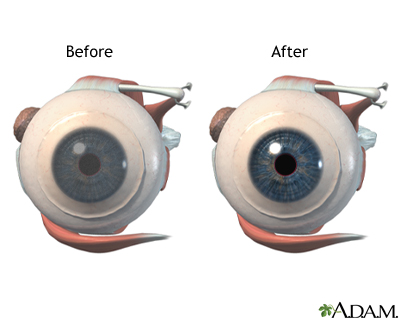Corneal transplant or Keratoplasty; Penetrating keratoplasty
The cornea is the clear outer lens on the front of the eye. A corneal transplant is surgery to replace the cornea with tissue from a donor. It is one of the most common transplants done.
Description
You
will probably be awake during the transplant, but you will be given
medicine to relax you. Local anesthesia (numbing medicine) will be
injected around your eye to block pain and temporarily prevent eye
muscle movement.
The tissue for your corneal transplant will come
from a person (donor) who has recently died and who had agreed to
donate their tissue. The donated cornea is processed and tested by a
local eye bank to make sure it is safe for use in your surgery.
The
most common type of corneal transplant is called “penetrating
keratoplasty.” During this procedure, your surgeon will remove a small
round piece of your cornea. Then your surgeon will sew the donated
cornea into the opening of your cornea.
A newer technique called
lamellar keratoplasty may be used for some patients. During this
procedure, only the inner or outer layers of the cornea are replaced,
rather than all the layers. This technique can lead to faster recovery
and fewer complications.
Why the Procedure is Performed
A corneal transplant is recommended for people who have:
- Vision problems caused by thinning of the cornea, usually due to keratoconus (when less invasive treatments are not an option)
- Scarring of the cornea from severe infections or injuries
- Vision loss caused by cloudiness of the cornea, usually due to Fuchs' dystrophy
Risks
Sometimes,
the body rejects the transplanted tissue. This occurs in about one out
of three patients in the first 5 years. Sometimes rejection can be
controlled with steroid eye drops. However, there is always a risk of
rejection.
Other risks for a corneal transplant are:
- Bleeding
- Cataracts
- Infection of the eye
- Glaucoma (high pressure in the eye that can cause vision loss)
- Loss of vision
- Scarring of the eye
- Swelling of the cornea
The risks for any anesthesia are:
- Allergic reactions to medicines
- Breathing problems
Before the Procedure
Tell
your doctor about any medical conditions you may have, including
allergies. Also tell your doctor what medicines you are taking, even
drugs, supplements, and herbs you bought without a prescription.
You
may need to limit medicines that make it hard for your blood to clot
for 10 days before the surgery. Some of these are aspirin, ibuprofen
(Advil, Motrin), and warfarin (Coumadin).
You may take your other
daily medicines the morning of your surgery--but check with your doctor
first. Also talk to your doctor if you take diuretics (water pills) or
insulin or pills for diabetes.
You
will need to stop eating and drinking most fluids after midnight the
night before your surgery. You can have water, apple juice, and plain
coffee or tea (without cream or sugar) up to 2 hours before surgery. Do
not drink alcohol 24 hours before or after surgery.
On the day of
your surgery, wear loose, comfortable clothing. Do not wear any jewelry.
Do not put creams, lotions, or makeup on your face or around your eyes.
You will need to have someone drive you home after your surgery.
Note: These are general guidelines. Your surgeon may have specific requirements or instructions.
After the Procedure
You will go home on the same day as your surgery. Your doctor will give you an eye patch to wear for about 1 to 4 days.
Your doctor will prescribe eye drops to help your eye heal and prevent infection and rejection.
Your
doctor will remove the stitches at a follow-up visit. Some stitches
may stay in place for as long as a year, or may not be removed at all.
Outlook (Prognosis)
Full
recovery of eyesight may take up to a year. This is because it takes
time for the swelling to go down. Most patients who have successful
corneal transplants will enjoy good vision for many years. But, if you
have other eye problems, those problems may still reduce your eyesight.
Often
glasses or contact lenses may be needed to achieve the best vision.
Laser vision correction may be an option if you have nearsightedness,
farsightedness, or astigmatism after the transplant has fully healed.
References
Blackmon S, Semchyshyn T, Kim T. Penetrating and lamellar keratoplasty. In: Tasman W, Jaeger EA, eds. Duane's Ophthalmology. On DVD-ROM. 1st ed. Philadelphia, Pa: Lippincott Williams & Wilkins; 2012:chap 26.
Yanoff M, Cameron D. Diseases of the visual system. In: Goldman L, Schafer AI, eds. Cecil Medicine. 24th ed. Philadelphia, Pa: Saunders Elsevier; 2011:chap 431.
source: http://www.nlm.nih.gov/medlineplus/ency/article/003008.htm



